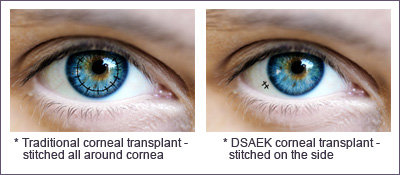DSEK: The partial corneal transplant
 If a cornea has become opacified by disease or has become irregular in contour, vision will be impaired. In such cases, the cornea can be replaced with a either with full thickness donor cornea in a conventional transplant, or partially replaced by a procedure known as DSEK. DSEK is an acronym for Descemet’s Stripping Endothelial Keratoplasty, and is used for diseases that primarily affect the cells that line the inside of the cornea such as Fuchs’ Dystrophy or select cases of corneal swelling after eye surgery. This layer of cells, called the endothelium lies on a removable membrane called Decemets Membrane, and can be replaced surgically. In DSEK, Decemets Membrane and the endothelial lining of the cornea are removed through a small incision in the eye and replaced with a small disc of donor cornea bearing this important cell layer.
If a cornea has become opacified by disease or has become irregular in contour, vision will be impaired. In such cases, the cornea can be replaced with a either with full thickness donor cornea in a conventional transplant, or partially replaced by a procedure known as DSEK. DSEK is an acronym for Descemet’s Stripping Endothelial Keratoplasty, and is used for diseases that primarily affect the cells that line the inside of the cornea such as Fuchs’ Dystrophy or select cases of corneal swelling after eye surgery. This layer of cells, called the endothelium lies on a removable membrane called Decemets Membrane, and can be replaced surgically. In DSEK, Decemets Membrane and the endothelial lining of the cornea are removed through a small incision in the eye and replaced with a small disc of donor cornea bearing this important cell layer.
The replacement of the diseased endothelial cells allows the cornea to once again become clear by restoring more normal function. In comparison to conventional full-thickness transplants, recovery after DSEK is more rapid – the cornea may be greatly cleared within 4 to 6 weeks after the procedure. A major drawback of this procedure is some uncertainty about initial donor disc adherence. Occasionally, the donor tissue fails to attach to the recipient cornea, and may need to be repositioned surgically or replaced entirely. Like penetrating keratoplasty, DSEK is a corneal transplant procedure, with the same implications for long-term use of eyedrops and follow-up examinations as for conventional transplant surgery.
Advantages of DSEK as compared to standard corneal transplantation are:
- The eye is left much stronger and more resistant to injury, since the incision is smaller and heals with greater strength.
- There is less uncertainty and potential for change in refractive error (especially astigmatism) because the patient’s corneal structure is altered less.
- Suture-related problems can be minimized
- DSEK offers patient’s more rapid visual recovery than standard corneal transplantation.
Note that DSEK is only suited for patients who have a corneal disease arising from endothelial dysfunction, e.g. patients with conditions such as Fuchs’s dystrophy, bullous keratopathy or failed prior corneal transplants. It is not possible to treat keratoconus, scars or hereditary corneal dystrophies with DSEK.
